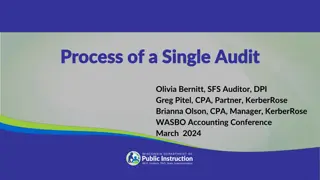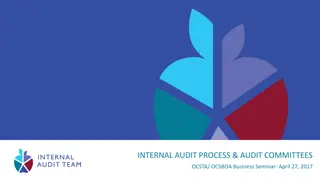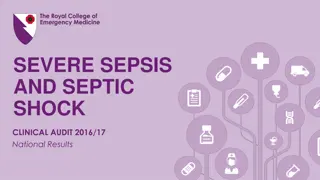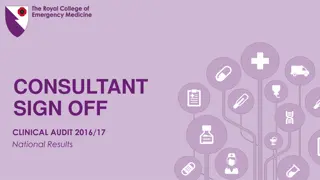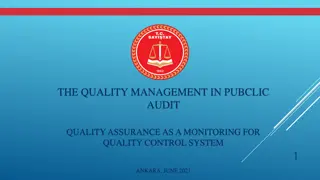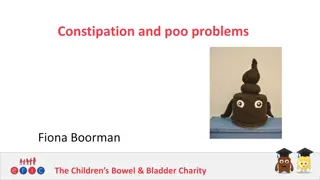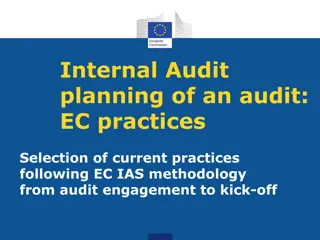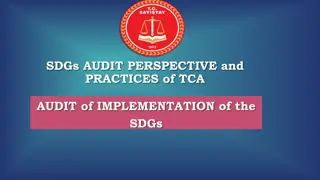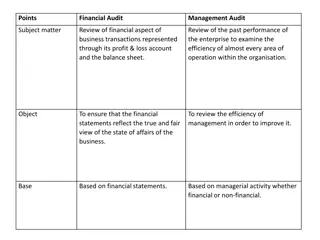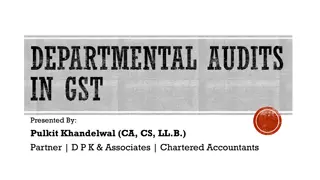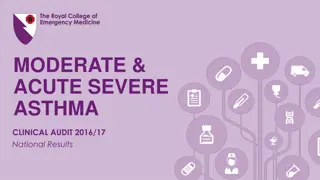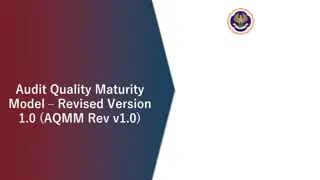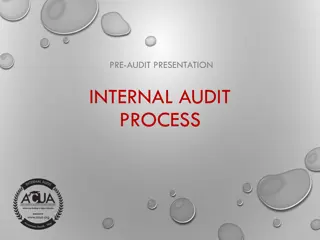Constipation Audit Tool Implementation
Aimed at piloting a constipation audit tool in adult palliative care settings across Ireland, this project focuses on assessing current practices, tool applicability, clinician feedback, and future recommendations. The process involved developing an audit proposal, creating a staff questionnaire, seeking approvals, conducting audits, and collating data for analysis. The audit cycle follows guidelines, sets standards, measures practice, re-audits, reflects on changes, ensures compliance, and formulates action plans for improvement.
Download Presentation

Please find below an Image/Link to download the presentation.
The content on the website is provided AS IS for your information and personal use only. It may not be sold, licensed, or shared on other websites without obtaining consent from the author.If you encounter any issues during the download, it is possible that the publisher has removed the file from their server.
You are allowed to download the files provided on this website for personal or commercial use, subject to the condition that they are used lawfully. All files are the property of their respective owners.
The content on the website is provided AS IS for your information and personal use only. It may not be sold, licensed, or shared on other websites without obtaining consent from the author.
E N D
Presentation Transcript
NDT 1: Constipation: Audit in Motion Lesley Rutherford Nurse Consultant in Palliative Care, Marie Curie Hospice
NDT: Audit in Motion Constipation Audit Tool Edith Geraldine Lesley Rutherford, Nuala Ginnelly, Trish Curran McMahon, Tracey, Fiona Jean Gilmour, Barber, October 2015
Aim: To pilot the constipation audit tool in a variety of adult palliative care settings , across the Island of Ireland, to ensure its suitability nationally
Objectives: To obtain an overview of current practice within a variety of clinical settings To determine the applicability of the tool within the individual settings To determine the experience of using the tool from the clinicians perspective To make recommendations in relation to the design and content of the tool for future use
Process: Audit proposal was developed A brief staff questionnaire was developed to accompany the audit tool in order to elicit feedback on the design/usability of the tool itself Pilot representation across the Island of Ireland and representation from a range of settings clinical areas were identified ensuring geographical Explanatory information developed for staff participating in the audit Approval sought ( where necessary) from audit groups within each organisation.
Process contd; NDT setting who were willing to participate in the audit. Members identified colleagues within their own All participating staff were given an explanation of the background to the project and rationale for audit. The audit was undertaken on one day only. NDT members collated data from each individual site which was then subsequently recorded on a master copy on Excel database.
Audit Cycle: Set from the recommendations in Management of Constipation in Adults Receiving palliative Care Guidelines Set standards Using the data Collection form from the guidelines Measure current practice Re-audit using the same tool and measure changes in practice Re-audit Reflect, plan, change and implement change Compare results to the recommendations in the guidelines. Compliance aims to be 100% Compare results to standards Formulate an action plan
Sample: 101 patients were included OLH & CS Blackrock IPU OLH &CS Blackrock Community Palliative Care OLH & CS Blackrock Day Hospice St Michaels Hospital North West Hospice IPU North West Hospice Community palliative care Sligo Regional Hospital palliative care team University Hospital Limerick Havenwood Nursing Home Macmillan Specialist Palliative Care Unit in AAH NHSCT Regional Cancer Centre; BHSCT 11 14 10 6 4 6 11 15 7 12 ROI ROI ROI ROI ROI ROI ROI ROI RO1 NI 6 NI
Areas included in the audit: Assessment Digital rectal examination Rationale for plain films of abdomen ( if undertaken) Education on non drug measures Consideration of non-pharmacological strategies Prescribing Use of pharmacological agents in bowel obstruction
Staff Questionnaire What was your experience of using the tool? How do you feel about auditing your own practice? Is this tool applicable in your clinical setting? What adaptations do you deem necessary? What did you learn from using the tool? What adaptations would you deem necessary?
Results in relation to practice: Findings have been analysed and discussed in the final report. Overall the auditors were very receptive to auditing their own practice and welcomed the use of a tool. This positive response lends itself to considering such an approach with other guidance documents implemented locally and nationally The auditors found the concept of an audit tool a good resource for education when implementing new guidance. The auditors welcomed the opportunity to reflect on their own practice
Results contd: It highlighted gaps in current practice in comparison to the best practice approved recommendations. This was evident not just in acute settings but also in the specialist palliative care settings. Some of the best practice recommendations were questioned e.g maximising on one single laxative before the addition of another and optimisation of a stimulant agent before adding a softener The consistent challenge for auditors were the recommendations related to DRE . Concerns were raised re roles, responsibilities and competency. It was highlighted that some recommendations would be difficult to implement in particular clinical settings e.g plain film x-ray for patients in a nursing home setting The auditors found some of the questions ambiguous
Recommendations: There should be explicit instructions as to when and with whom the audit tool should be used (eg all palliative care patients or only palliative care patients who are constipated ) Some of the questions need to be reviewed and made more explicit and concise. In particular, questions that have several parts need to allow for each part to be answered individually, instead of one global answer. The tool may need modification to suit the various clinical settings( however if questions are made more explicit and concise this may not be necessary) More room for making comments would be useful, especially when Not applicable is selected
Recommendations contd: The inclusion of more patient related information, such as diagnosis, would make analysis of the data more meaningful. An appendix at the back of the guidelines with a flow chart outlining the management of constipation would be useful The issue of DRE needs particular attention and if the recommendations remain unchanged , there would need to be a robust, competency based training programme and assessment process. Given that fact that some of the recommendations from the National document differ from current practice and has been challenged by some auditors, it is recommended that individual organisations formally endorse the National document.
Recommendations contd: As the auditors on this occasion were nurses, it remains to be seen what challenges remain when implementing the national guidance document with medical staff therefore suggest consideration of this group before launching the document The wording on the formal audit report on the Excel Clinical Audit Tool database needs to be reviewed to accurately reflect the findings ( e.g Criteria 11)
Challenges: Work commitments imposed by own and other colleagues annual leave, limited members availability for collating data and connecting remotely to discuss progress. Technical issues re inputting data to excel data base over multiple sites for relatively novice users. Continuous remote collaboration to overcome hiccups as they occurred via teleconference and email Time management




